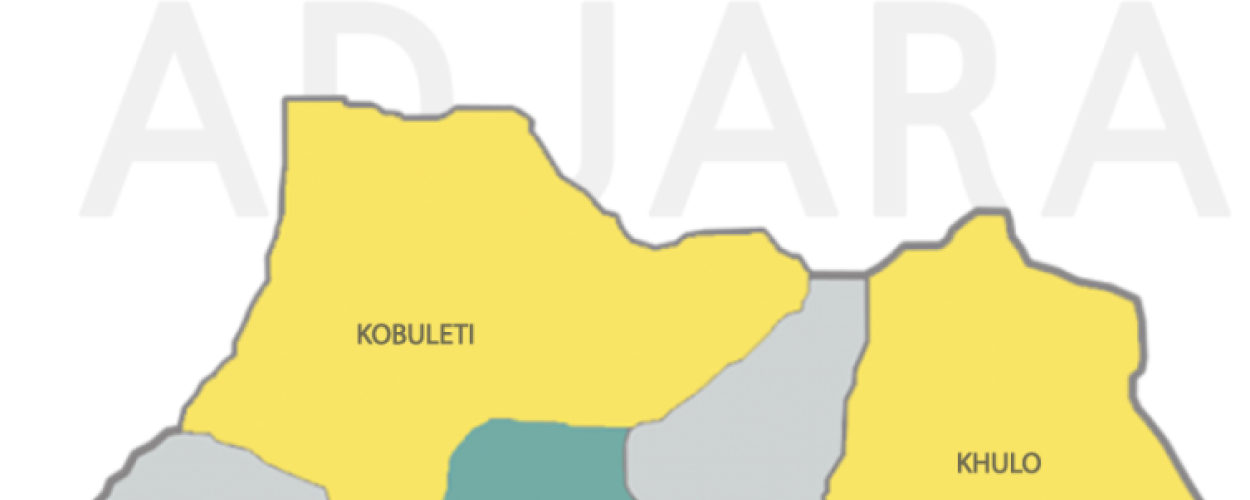General

About Keda
The Keda Municipality is located in the middle of the Adjaristskali river basin. The Keda Municipalty shares a 38 km-long border with the Kobuleti Municipality to the north, a 24 km-long border with the Shuakhevi Municipality to the east, a 24 km-long border with the Khelvachauri Municipality to the west, and a 17 km-long border with Turkey to the south. The Shavsheti and Meskheti mountain ranges run through the southern part of the Municipality while the Kobuleti mountain range runs through the north/north-west part.
The total area of the municipality is 452 km2, with a population of 21,244. The municipality consists of 10 communities and 64 settlements. The town of Keda, located 200 m above sea level, is an administrative center of the municipality.
Areas located along the Adjaristskali River are characterized by a Mediterranean subtropical climate. Humidity increases with altitude. Two soil zones, mountain-forest and mountain-meadow, are found on the territory of the municipality. Vegetation and fauna are rich and diverse. Mainly deciduous tree species are widespread. The distribution of conifers is relatively limited. The main agricultural activities include fruit farming, vine growing, crop growing, vegetable growing, bee-keeping, as well as fish (trout) farming (in Oktomberi, Agara, Tsoniarisi, Tskhmorisi).
The Keda Municipality is notable for its unique vine varieties. Local vines, Kedis Tsolikauri and Chkhaveri, are in high demand. There are a number of vine cellars: M.Shervashidze – village Pirveli Maisi, Lado Shavishvili – village Vaio, Nuri Sirabidze – village Gegelidzeebi.
The Municipality is rich in various mineral resources such as copper and gold deposits (in Merisi, Vaio) and medicinal and mineral waters, the most notable being Kokotauri and Gundauri waters. Kokotauri has been awarded an international certificate.
Historical heritage sites consist mainly of cultural monuments: watchtowers in Kaviani, Gulebi, Dzentsmani, Sagoreti, Tsivasula; arched stone bridges in Makhuntseti, Pirveli Maisi, Tsoniarisi, Dandalo; and fortresses in Zendidi, Tsivasula.
Diverse flora and fauna, as well as numerous waterfalls can be observed by visitors in the gorges of Adjaristskali and other mountainous rivers flowing in the territory of Keda Municipality.
The Keda Municipality is subdivided into nine administrative units:
The total area of the municipality is 452 km2, with a population of 21,244. The municipality consists of 10 communities and 64 settlements. The town of Keda, located 200 m above sea level, is an administrative center of the municipality.
Areas located along the Adjaristskali River are characterized by a Mediterranean subtropical climate. Humidity increases with altitude. Two soil zones, mountain-forest and mountain-meadow, are found on the territory of the municipality. Vegetation and fauna are rich and diverse. Mainly deciduous tree species are widespread. The distribution of conifers is relatively limited. The main agricultural activities include fruit farming, vine growing, crop growing, vegetable growing, bee-keeping, as well as fish (trout) farming (in Oktomberi, Agara, Tsoniarisi, Tskhmorisi).
The Keda Municipality is notable for its unique vine varieties. Local vines, Kedis Tsolikauri and Chkhaveri, are in high demand. There are a number of vine cellars: M.Shervashidze – village Pirveli Maisi, Lado Shavishvili – village Vaio, Nuri Sirabidze – village Gegelidzeebi.
The Municipality is rich in various mineral resources such as copper and gold deposits (in Merisi, Vaio) and medicinal and mineral waters, the most notable being Kokotauri and Gundauri waters. Kokotauri has been awarded an international certificate.
Historical heritage sites consist mainly of cultural monuments: watchtowers in Kaviani, Gulebi, Dzentsmani, Sagoreti, Tsivasula; arched stone bridges in Makhuntseti, Pirveli Maisi, Tsoniarisi, Dandalo; and fortresses in Zendidi, Tsivasula.
Diverse flora and fauna, as well as numerous waterfalls can be observed by visitors in the gorges of Adjaristskali and other mountainous rivers flowing in the territory of Keda Municipality.
The Keda Municipality is subdivided into nine administrative units:
- Town of Keda Administrative Unit - Town of Keda, villages - Keda, Gulebi, Khunkuda, Ortsva, Arsenauli, Shevaburi, Dzentsmani, Koromkheti, Tskhemna, Akutsa, Zendidi.
- Dandalo Administrative Unit. Villages - Dandalo, Takidzeebi, Mosiashvilebi, Gogiashvilebi, Baladzeebi, Kharaula, Jalabashvilebi.
- Zvare Administrative Unit. Villages - Zvare, Zesopeli, Kvashta, Sirabidzeebi, Vaio.
- Makhuntseti Administrative Unit. Villages - Zeda Makhuntseti, Kveda Makhuntseti, Zundaga, Zeda Bzubzu, Kveda Bzubzu, Uchkhiti, Namlisevi, Kosopeli, Milisi, Dologani, Chalakhmela, Chinkadzeebi.
- Merisi Administrative Unit. Villages - Merisi, Sikhalidzeebi, Inasharidzeebi, Garetke, Gundauri, Namonastrevi, Silibauri.
- Oktomberi Administrative Unit. Villages - Oktomberi, Tskhmorisi, Akho, Chetkidzeebi, Gobroneti, Kokotauri, Gegelidzeebi.
- Tsoniarisi Administrative Unit. Villages - Tsoniarisi, Varjanisi, Tibeta, Kantauri, Abukeda, Sasadilokeli, Sabaduri.
- Tskmorisi Administrative Unit. Villages - Tskmorisi, Agho, Chetkidzeebi, Gobroneti, Kokotauri, Gegelidze
- Tsoniarisi Administrative Unit. Villages - Tsoniarisi, Varjanisi, Tibeta, Kantauri, Abukeda, Sasadilokeli, Sabaduri.

